If you would like me to summarize Egypt (Misr in Arabic), then Pyramids, Mummies, river Nile, Cairo, Al Azhar, Ume Kalsoom, Cleopatra and Suez Canal will do the job. You can only imagine how excited I was visiting this country.
I was lucky that I visited a new Egypt; an Egypt without Mubarak! I roamed freely in streets around Tahrir Square which was the centre of uprising few days ago, life has come to a normal now. I felt a sigh of relief & hope for good future in every Egyptian I spoke to. I believe it is not because Mubarak is gone; rather it is the barrier that has broken i.e. “People cannot bring the change”. People can! If they really want to, though it demands hard work & sacrifice – Egyptians did it with their blood & toil.
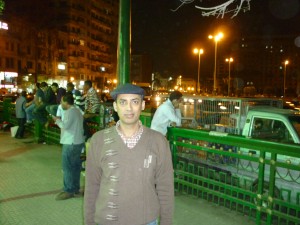
Egypt is the most populous Arab country with population of around 80 million, which is nearly 25% of the whole Arab nation. Cairo is heavily crowded city with about 18 million residents. About 94% people are Muslims and 6% Coptic orthodox Christians.
96% of Cairo is dry desert; area around Nile is the only green & fertile part. Egypt borders with Mediterranean Sea in north, Sudan in south, Red Sea & then Saudi Arabia in east, and Libya in west. There is a little border with Israel in north-east which was closed by the Egyptian government during the intifadah (uprising) in Palestine to punish them even more. Palestinians were not allowed to take refuge in Egypt from Israeli attacks nor was humanitarian aid allowed in from Egypt. Thanks God old regime is gone.
Weather is dry & hot mostly, November through March are the best months to visit. I visited in March, to my surprise days were excellently pleasant but nights were cold. My wife advised to take a sweater along which turned out to be quite handy.
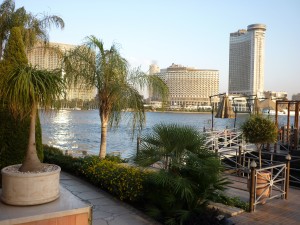
Egypt earns most of its revenue from tourism followed by toll tax from Suez, and oil & minerals. Don’t even talk to a tree in Cairo, otherwise it will start selling something to you. Dealing with tourists is in Egyptian blood since millenniums. Their civilization is so old that even Romans and Greeks used to come here for tourism. First question you would get is where are you from, so they can assess how rich you are? Then they will become friendly, innocently asking, first time here? Oh I know a hotel which is the ‘cheapest’ in Cairo…
I asked for a prayer room at the airport. The person took me to the room, but briefly stopping on a taxi counter. “Their service is the best in the city, price is $xx, after finishing prayer just come back here”. I nodded OK. The price quoted to me was a bit high, just double than what I paid later to a taxi outside. I stayed at Siftel, a beautiful Hotel on the banks of river Nile. We had breakfast sitting outside overlooking Nile and Cairo buildings, a wonderful experience.
Let’s Go Pyramids:
Pyramids at Giza are the only surviving structure from the 7 wonders of ancient world. We passed near Pyramids many times during my stay but I couldn’t get closer. Then on last day I hired a taxi to visit Pyramids (Ahram) with a guide/driver Mr Mohamed, an old Egyptian talking machine. As soon as we drove off he started broadcasting Egyptian history, inserting ads in between. “…After visiting the Pyramids we will stop at a great souvenirs factory. They are very hospitable people; we will have a ‘free’ cup of qahva and have a look at their work. You can buy if you like anything, no obligations of course”…. I politely said no, it was ignored. A second strong ‘NO’ worked, history remained but ads disappeared.
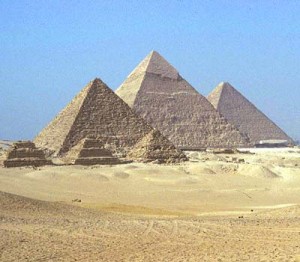
But it was a great decision to take him along. Never ever go alone to Pyramids. There are many touts there who would become physical with you to sell something be it guidance, horse / camel ride, a souvenir or just to suggest a place to take photo. It was sadly pathetic; the people even hit our taxi physically because they lost business due to it.
The three Giza pyramids are known as great pyramids and belong to father Khufu, son Khafre and one of their successor. You can either walk between three pyramids or use taxi. Each pyramid is about few hundred meters away from each other. Pyramids were built as burial places for Pharaohs (kings). A long narrow tunnel takes to a tiny room in the centre where the King was buried, along with items which he might need in the life after. These items have been stolen now and Kings gone to live in more modern air-conditioned facilities known as museums.
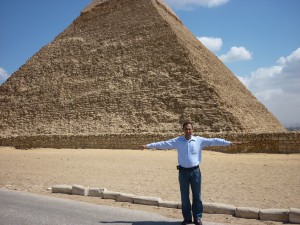
Biggest and the oldest (built 5000+ years ago) is called Pyramid of Khufu. It is 148 meters high & 230 meters long. Nearly 2.3 million limestone blocks of 2.5 tonne each on average were used; some weigh up to 16 tones. Stone was taken from Muqattam hills about 30 miles away. It is built with layers of stone, each top layer is slightly smaller than the lower hence a pyramid like shape is achieved.
God knows how they carried such heavy stones to the site and lifted them up without modern machines. As legend goes they were very strong people who could carry one stone each. Pyramid of Khufu remained the highest building in the world until recent developments. The pyramids are true mathematical marvel. They are exact square, and sides are aligned perfectly with the north.
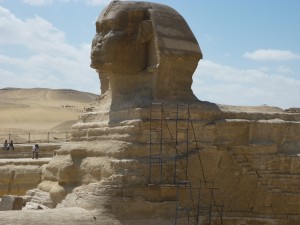
Then there is statue of Sphinx, a lion with the head of a woman, it is known as Abu Al Haol “father of terror”. Its nose has gone missing. According to Mohamed, it was Napoleon Bonaparte who broke it and took it to Louvre museum in Paris, just to rip Egypt off its assets. But books say it just broke off over time.
Here comes the Mummy:
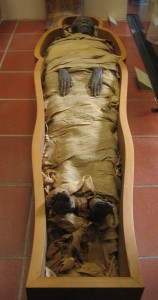
Old Egyptians believed in eternal life hence they mummified (preserved) their dead. In fact their belief was based on a complex array of myths, consisting of strange rituals, funny theories and multiple gods controlling the universe. The burial ritual started by removing the dead person’s organs, except heart – it was required in after life. The body was either left in sand or salt to dry for a month. This dehydrated body was then wrapped in strips of cloth, and finally placed in a wooden human-shapped coffin. This was then placed inside the pyramid. The jackal-faced god Anubis would then weigh the heart of dead person against the feather of truth in front of the jury of other gods. If lighter or equal, person lived eternal life. Tough luck otherwise, jackal gobbled him up..
The story continues… Read Part 2 Here with Egypt’s two most famous Women (Cleopetra & Ume Kulsoom) and two most known Waterways (Nile & Suez).
Kashif bhai,
Nice one…
I guess your next stop ought to be the Louvre, to clarify the mystery of Abu al Haol’s nose!
😉
I love Egypt it is hitorical country. The pictures which you have shown are beautiful. I have read many books about Egypt, it is country of prophets.
Salaamualaikum bhaijaan,
im really envious of the kind of Job you have which takes you to places. This not only is a great adventure for one life but I believe it widens your horizons since you learn to incorporate various viewpoints, accommodate various cultures etc.
By the way, egypt sure is a lovely place. May Allah SWT help them to stand on their own feet. They have such an old civilization.
Salaamualaikum